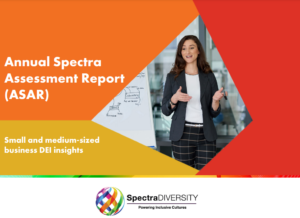Myth: Trickle Down Economics Works Since the days of Ronald Reagan, many have promoted the…

Building Effective Teams Across Generations
Combat Ageism in the Workplace with Inclusion Strategies
Ageism affects all generations in the workplace, from younger Gen Z and Millennial employees dismissed for inexperience to Baby Boomers and Gen X overlooked as they age. Women over 40 face the added challenge of sexism, with their workplace value perceived to decline just when their experience and confidence are at their peak.
 It’s a sucker punch of ageism wrapped in sexism with a dash of insult — and for women of color, this age ceiling is even lower and reached earlier.
It’s a sucker punch of ageism wrapped in sexism with a dash of insult — and for women of color, this age ceiling is even lower and reached earlier.
According to Birmingham University’s center for research in race and education, Black women are twice as likely as their white counterparts to be working in insecure jobs.
The experiences of Black women are backed up by Spectra Diversity data which shows that Black women have among the lowest perception of their organization’s culture, management and 3Ps (policies, practices and procedures). The notably low ranking of management by BIPOC, multiracial and LGBTQ or Non-binary groups relative to white/Caucasian respondents seen in the 2023 Spectra Diversity ASAR coincides with a larger perception captured by a 2020 Pew Research survey.
By understanding how ageism plays out across all demographics, businesses can take concrete steps to foster an inclusive workplace, leveraging the strengths of all generations for a healthier, more dynamic work environment.
Data Demonstrates Differences in Perceptions

Data from the 2023 ASAR revealed differences in perceptions among other employee demographics too. Younger employees, including Gen Z and millennials, tend to view management less favorably compared to older generations, which aligns with studies showing that values-driven employees are more likely to reject employers not aligned with their ethics. This data underscores the importance of regularly assessing employee perceptions to identify and address gaps in DEI and workplace experiences.
Generational Divide: Older Employees Feel Fair Treatment, While Younger Workers Disagree
The differences in how employees feel show up in the data too, with younger generations often reporting less positive views of management and workplace practices compared to their older counterparts.
The statement below is from the Spectra Assessment and the results is from a small organization of just 69 people. However, it shows how stark the differences can be comparing the older generation to the younger ones.
Management holds all employees equally accountable for their actions and behaviors:
Clearly the older generation is feeling a fairness in the treatment from management (85% agree/strongly agree) that the younger generations are not feeling (67% disagree or strongly disagree). Given that management is often composed of mostly older, white, straight males, it is not surprising that the overall results line up in this manner.
Tips for Working With Younger Generations
 Younger employees tend to be more diverse and they have more developed interpersonal skills related to diversity, equity and inclusion. These employees can have a transformative impact on the organizations where they work.
Younger employees tend to be more diverse and they have more developed interpersonal skills related to diversity, equity and inclusion. These employees can have a transformative impact on the organizations where they work.
If you’re a Baby Boomer or member of Gen X looking to connect effectively with younger colleagues, consider these insights to enhance collaboration and understanding across generational lines.
- Facilitate, Don’t Direct: Guide them with what to achieve and why, but give them space to find their own methods without micromanaging.
- Provide Soundbites, Not Speeches: Younger employees respond well to clear, concise suggestions. Use “lightweight signals” for better communication.
- Connect Them to the Mission: Show how their work ties into the larger company purpose to give their role meaning.
- Encourage Continuous Learning: Offer training and development opportunities as they value skill growth and learning.
- Promote Flexibility: Support work-life balance by allowing flexibility in how and when they work.
- Encourage Open Communication: Create a space where younger employees feel safe to share ideas and concerns without judgment.
- Provide Opportunities for Growth: Offer meaningful feedback, mentorship, and training to support skill development and career advancement.
- Foster Work-Life Balance: Respect their need for flexible schedules and integrate their work with their personal values and lifestyle.
- Recognize Achievements: Celebrate both small and large successes, showing appreciation for their contributions.
- Involve Them in Decision-Making: Empower younger employees by giving them a voice in projects and company goals.
How to Work with Older Generations

Working with older employees brings a wealth of experience, knowledge, and perspective to the workplace. They often possess strong problem-solving skills and a deep understanding of industry practices, having navigated a range of challenges throughout their careers. Their mentorship and ability to guide younger employees can boost team performance and foster a culture of learning. Additionally, older employees may have well-developed interpersonal skills and strong work ethics, contributing to team stability and enhancing overall workplace productivity. Their long-term perspective can also help companies make more strategic decisions.
If you’re part of a younger generation, collaborating with older colleagues can sometimes be challenging.
Here’s how to make it work:
- Be Direct: Older employees often respond well to clear requests and deadlines.
- Don’t Assume Tech Incompetence: While some may struggle, many are tech-savvy; approach each individual uniquely.
- Value Their Experience: They’ve accumulated significant knowledge over the years—treat it as wisdom.
- Respect Their Time: Socializing outside work might not be an option due to family responsibilities.
- Prefer Emails Over Texts: Use email for non-urgent communication; reserve texts for important matters.
- Be Patient: Older colleagues might take more time to adapt to new approaches or repeat themselves—patience goes a long way.
- Understand Work-Life Balance: Many older employees may not be checking email outside of work hours, so set expectations for response times.
- Leverage Their Strengths: Some may excel in areas like face-to-face communication or project management, so find ways to collaborate effectively using their skills.
- Respect Work Routines: Many are comfortable with structured workdays and set deadlines, so providing consistency can help foster better teamwork.
Inclusive Leadership Strategies
How can you build a workplace that’s welcoming to all generations? As a leader, here are actionable steps you can take to create an environment that supports employees of every age:
- Encourage Intergenerational Mentorship: Pair up employees from different generations to facilitate skill-sharing and deeper understanding.
- Model Diversity: If you say you value diversity in the workforce – prove it by having diversity on your leadership team. Engage in leadership coaching to improve your understanding of inclusivity.
- Avoid Sending Mixed Messages: Don’t talk about policies or have them in an employee handbook when they aren’t true. If you demonstrate that vacations are truly vacations, then be sure not to make employees feel like they are doing something wrong or that they should feel bad about taking a vacation. If you have “inclusion” in your organization’s mission statement – make sure it is tied to accountability of the management team.
- Assess Team Dynamics: When you’re conducting meetings – are some people contributing less? Do you need to draw out the younger team members? Do you need to acknowledge the experience of older team members? Work to understand how each person is being present based on their interactions.
- Create Guidelines and Expectations: Train management and employees on organizational policies and expectations. While managers may communicate in some way or another with employees after work hours without needing an immediate response, employees who get after hours calls or emails, are more likely to feel pressured to respond after work as well.
- Look for Bias in Your Policies, Practices and Procedures: When looking at your older employees, consider that a bad performance review can stick around as residue and rule an employee out for a promotion or key project assignment. Consider setting up a team of reviewers for promotions so that one individual doesn’t have undue influence. Remember that most people are most comfortable with people who are like themselves – so include diversity on your team of reviewers to reduce bias.
- Support Work-life Balance: Encourage and support work life policies if they want to remain competitive. Flexibility is key particularly to millennials, but everyone benefits. Done right, employers and employees both benefit.
Leverage Data to Improve Inclusivity
Data is essential for understanding and addressing diversity and inclusion challenges within an organization. Tools like the Spectra Diversity Inclusion Assessment allow leaders to monitor employee perceptions regularly and identify hidden workplace dynamics, such as gaps in perceived fairness across generations.
By collecting ongoing feedback, you gain actionable insights into your organization’s culture, policies, and practices. These insights enable you to make informed decisions, set targeted DEI goals, and track progress over time, ensuring a workplace culture that evolves with the needs of all employees.
Resources
Books
White Paper
Engaging the Workforce Across Generations (PDF)
Articles
‘True Gen’: Generation Z and its implication for companies | mckinsey.com
11 problems with Gen Z in the workplace: Challenges & strategies | HiBob
Have Smartphones Destroyed a Generation? | The Atlantic
There Are Now 5 Generations in the Workforce—Can They Work Together? | Medium
The Secrets to Effective Multi-Generational Leadership | Medium




